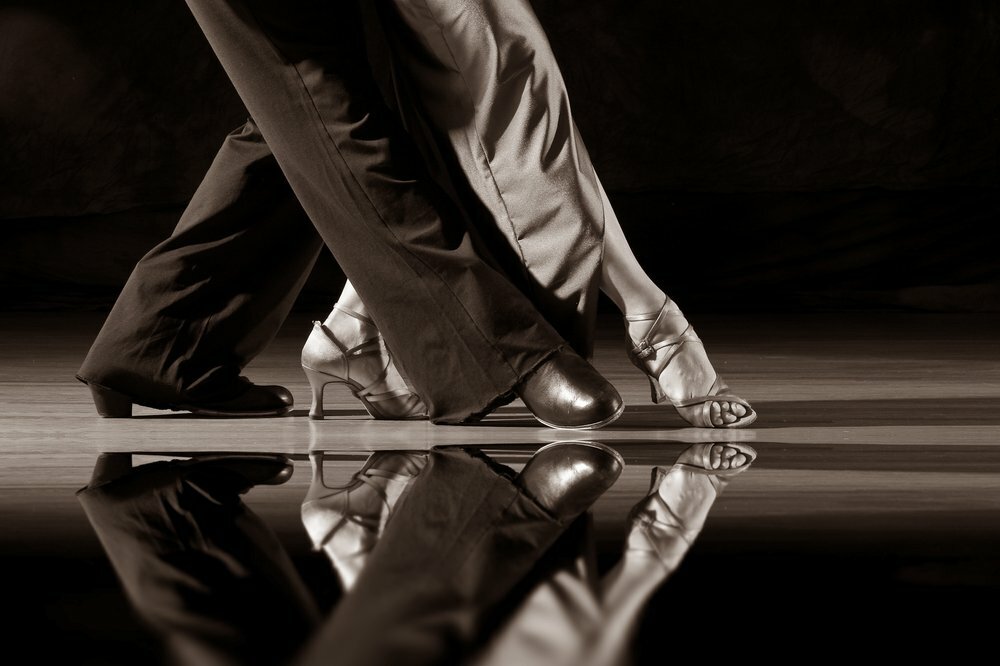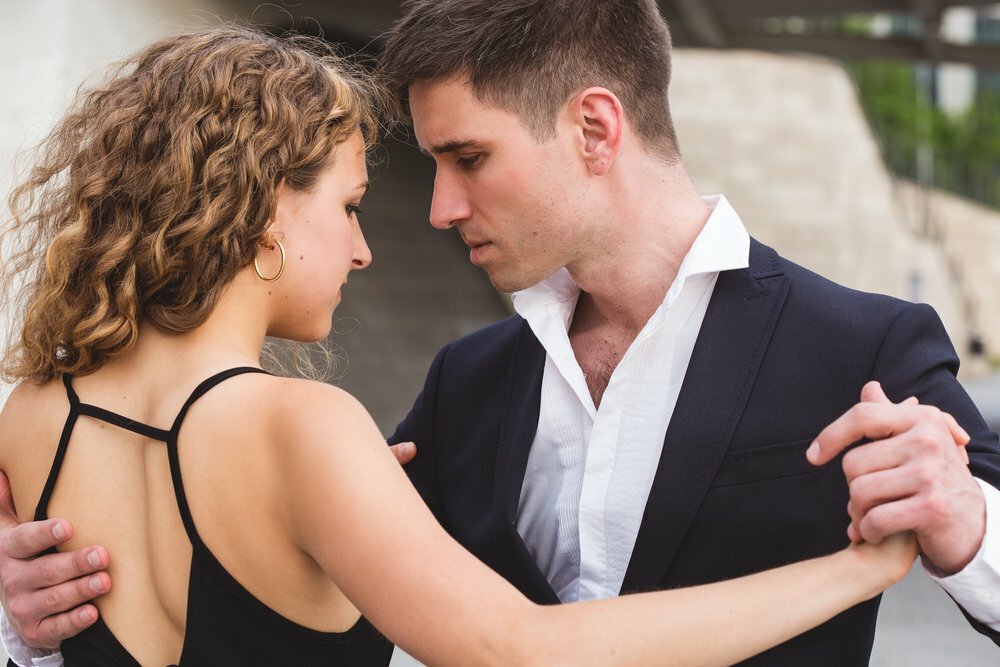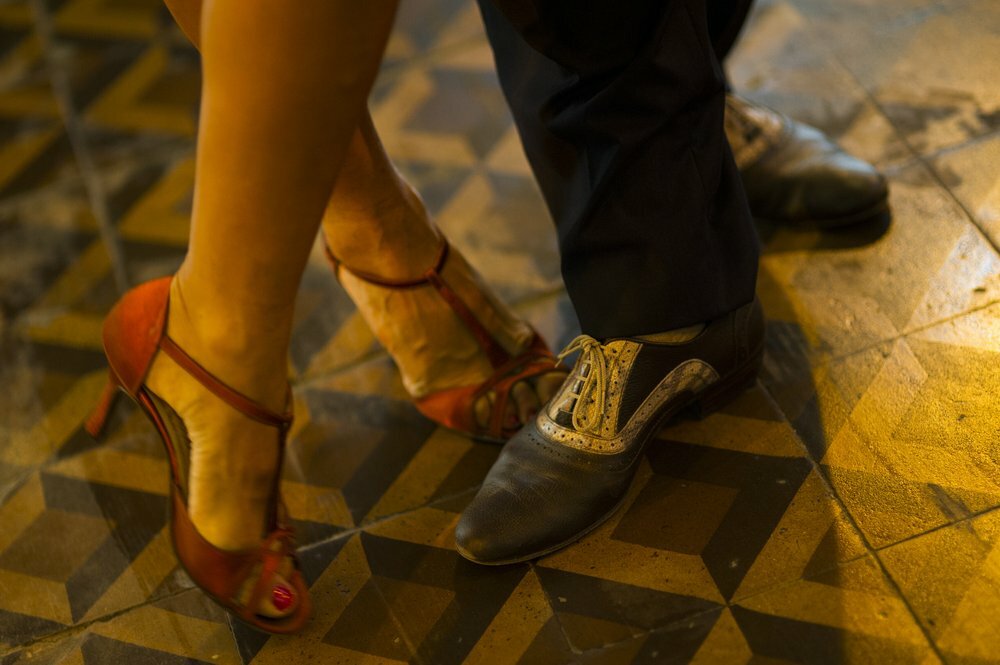As with anything one wishes to learn, understanding the related terminologies are important — and Argentine tango is no exception.
While one might argue that tango is a dance and executing the steps elegantly is a dancer's ultimate goal, knowing its terminologies remains fundamental.
For one thing, being familiar with what tango's elements are called brings one closer to the proper execution of its steps. It also makes it easier to follow what the teacher or instructor is saying during lessons or practicas.
By being aware of the terminologies used, one can have a deeper grasp of its steps in reference with others, thereby achieving a cohesive understanding of the whole concept that makes tango beautiful.
In tango, one of the things that may perhaps be confusing to some beginners is distinguishing the giro from the molinete. This is understandable as both terms tend to be used interchangeably and are often understood synonymously with each other.
This then begs the question: what is the difference between the giro and the molinete? Is there really a difference between them?

Understanding the Giro and the Molinete
In understanding tango terminology, one must first go back to the root of the word. Though the terms used in tango are mostly in Spanish, these come in the form of words that directly describe the step itself. In the case of the giro and the molinete, here are its basic definitions as stated by Argentine Tango Lab:
GIRO - Turn; a turning step or figure.
MOLINETE - Windmill; wheel.
At the onset, these two terms seem quite simple to understand, but what makes them somewhat confusing involves their application on the dance floor.
Being among the fundamental steps in tango, the giro and the molinete are often executed together, which can make distinction rather difficult for the uninitiated, or even those who are on their way to transitioning from beginner to intermediate level learning.
As the giro is a simple term, one can look at the molinete’s definition for distinguishing factors. Since its root word is “windmill” or “wheel,” one can then easily imagine that the molinete involves one party being at the center of the other party’s movements, the latter referring to the turning mill.
In the same post by Argentine Tango Lab, the molinete has an accompanying definition:
“A figure in which the lady dances a grapevine on a circumference around the man, stepping side-back-side-forward using forward and back ocho technique and footwork, as the man pivots at the center of the figure. This is a very common figure in tango, which challenges both the man and the lady to maintain good posture, balance, and technique in order to perform it well. [The molinete is] one of the central codes of tango.”

Deconstructing the Giro and the Molinete
In further understanding the giro and the molinete, one may also distinguish one term from the other by perhaps determining which party is the main figure.
When it comes to the giro, the leader appears to be the main party upon which attention should be given. In defining the giro, a post from Tango Movement explains:
“Giros (pronounced ‘hero’) are not the easiest movements to master. The follower walks around the leader and the leader does elegant movements in the middle. His balance is put to the test… and so is hers.”
“This means both parties need to work hard not only to be perfectly in axis, but not to pull their partner off theirs! [...]
The giro provides the leader his chance to shine.
For most of the tango, he provides the frame to the follower’s painting, enabling her beautiful movements. But this is his moment in the spotlight when all eyes are on him.”
An important aspect one must also remember about the giro is that
it can also refer to the turns performed by both leader and follower as a couple, not only as individuals.
On the other hand, the molinete often draws attention to the follower’s movements. According to a post from the Max Planck Institute for the Physics of Complex Systems, “Normally, leading a molinete consists just of the man turning his upper body in the desired direction. His hands are used only as extensions of his upper body.”
This definition coincides with the one previously stated by the Argentine Tango Lab, wherein the follower dances the grapevine around the leader as the latter pivots at the center.
Further to the molinete, what is referred to as the “grapevine” or the “grapevine turn” is common in most social dances and the molinete is Argentine tango’s version of this step.
A post from Black Alert enumerates the three steps needed to execute the grapevine turn from a tango perspective:
“1) a dissociative backstep;
2) a circular side step;
3) a dissociative forward step.
Typically, there is a side step between the back and forward steps, and while you can start with the back step, you can also start with a forward step.”

Some Issues With Technique
In executing either a giro or molinete, the leader or the follower might have a better time performing these steps if they are aware of some issues or adjustments they can make.
A post from Fredosaurus outlines some common issues, a summary of which is found below. Awareness of these issues can help leaders and followers with their techniques:
Leader Technique Issues
● Chest position: The position of the leader’s chest is what indicates the lead. The chest should be rotated slightly ahead of the follower. This is also similar to leading by moving one’s shoulder back to make room for the follower.
● Initial step: The leader must let the follower know which step to begin with, whether with the front step or back step. Since most followers are already aware of the sequence once it begins, only a light lead is required. Indicating the initial step is only necessary when the movements deviate from the typical patterns or when one is about to exit the move.
● Invitation: The leader should gently invite the follower in the direction of the turn. One should not push the follower.
● Dissociation: The leader may use substantial dissociation depending on the footwork.
● Leader footwork: The leader’s footwork can have different variations. One common approach is to place one foot around behind (or in front of) the other in the direction of the turn. Afterward, swivel on both feet, repeating as necessary. A simpler but less attractive approach is to make many penguin-sized, wedge-shaped steps to rotate.

Follower Technique Issues
● Stepping around: This should be done around the leader, not away from them.
● Ankles: Ankles should be closed together during pivots.
● Big pivot: A substantial pivot, often done after the side step, is required from the follower. This is a rather demanding step that positions the follower to do the back step.
● Timing: The front and pivot combination and side and pivot combination typically need more time compared to the back and side steps. Thus, these are danced slower than the quick back and side steps.
● Dissociation: The follower’s chest should face the leader as much as possible by dissociating.
● Balls of the feet: Followers must remain on the balls of their feet with their chest forward. On the back step, one should be especially careful to stay forward, and the heels should not touch the floor.
● Power: It is common for the leader to provide the leading impulse. But in some advanced molinetes, it is the follower who supplies the leader with the turning energy as the latter is doing fancy footwork in the center. However, this is recommended only for more advanced dancers.
Tips for More Balanced Giros
When doing a giro or any tango turn, balance is paramount. Without the right balance, both dancers are at risk of falling out of their axes and bumping into other dancers or, worse, getting injured because of an accident. For more balanced giros, a video from Tango Space offers three insightful tips for leaders, which are summarized below:
● Keep a straight axis: The axis always needs to be straight. To maintain a good axis, the line of the hips and the line of the shoulders must be parallel to the floor.
● Be conscious of the position of the head: The head is the heaviest part of the body, which may cause the rest of the body to become unbalanced when the head is leaning to one side. There is a big tendency to move the head forward while doing the giro. Avoid this by keeping one's head straight and aligned with the spine. This is especially helpful when doing the giro with a lapiz or an enrosque.
● Keep a firm frame: The frame of the body must be kept firm. The arms must not be floppy as this can cause the follower to sway the leader into their direction, thus unbalancing the leader. To avoid this, one must keep the embrace firm and in front of the body.

Tips for Executing the Molinete
For the molinete, it is typically the follower who does most of the movements, but this doesn’t mean that the leader won’t have a role. In fact, a post from Black Alert states that the molinete has two parts that can be done individually by the leader and the follower:
“The common methodology (#1) is referred to as the follower’s molinete,
meaning that the follower will take those three steps [dissociative backstep, circular side step, and dissociative forward step] in a circular pattern of steps around their lead, while the lead would engage the lead’s giro at the same time.
“The less common methodology (#2) is referred to as the lead’s molinete. And, in this case,
the lead (the person) would lead (the action) themselves to take those three circular steps around their follower, while the follower is free to embellish or adorn (depending on the music) or is being led (at the same time) to rotate over one or both feet.”
It is important to remember, however, that the molinete might be better accomplished by more advanced dancers as it can feel like a more intermediate-level step. A post from the Max Planck Institute for the Physics of Complex Systems offers the following interpretation:
“You will not often do the grapevine in a straight line. As the dance floor curves and other couples get in your way, you will have to curve the grapevine. If you curve it so that it comes back to a starting point, you'll make a circle. As the circle becomes smaller, whoever is on the inside will have to take ever-smaller steps. When the circle becomes very small, the person on the inside will just stay in place and do a giro (turn) of some kind. This makes a figure of intermediate difficulty called the molinete (wheel).”

The Turning Point
While there may be some confusion as to the definition and distinguishing factors regarding the giro and molinete, what’s crucial about knowing these steps is that they are — quite literally and figuratively —
the turning points that can make one’s tango dancing achieve beauty, grace, and elegance.
Regardless of one’s skill level, practicing giros and molinetes regularly and properly will most definitely elevate not only one’s tango dancing experience but also that of their partner.
If you wish to learn Argentine Tango, we put our methodology in the book. You can reserve yours HERE.

